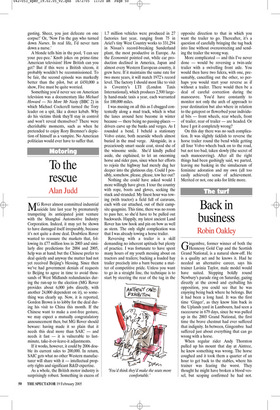To the rescue
Alan Judd
MG Rover almost committed industrial suicide late last year by prematurely trumpeting its anticipated joint venture with the Shanghai Automotive Industry Corporation. Indeed, it may yet be shown to have damaged itself irreparably, because it’s not quite a done deal. Doubtless Rover wanted to reassure the markets that, following its £77 million loss in 2003 and similarly dire predictions for 2004 and 2005, help was at hand; but the Chinese prefer to deal quietly and anyway the matter had not yet received Beijing’s blessing. Since then we’ve had government denials of requests to Beijing to agree in time to avoid thousands of West Midlands redundancies during the run-up to the election (MG Rover provides about 6,000 jobs directly, with another 24,000 dependent on it), so something was clearly up. Now, it is reported, Gordon Brown is to lobby for the deal during his visit to China this month. If the Chinese want to make a cost-free gesture, we may expect a mutually congratulatory announcement then, but MG Rover should beware: having made it so plain that it needs this deal more than SAIC — and needs it fast — it is vulnerable to lastminute, take-it-or-leave-it adjustments.
If it works, however, it could by 2006 double its current sales to 200,000. In return, SAIC gets what no other Western manufacturer will share with it — intellectual property rights and significant R&D expertise.
As a whole, the British motor industry is surprisingly robust. Something in excess of 1.7 million vehicles were produced in 27 factories last year, ranging from 75 in Ariel’s tiny West Country works to 331,294 in Nissan’s record-breaking Sunderland plant, the most productive in Europe. As the Economist pointed out, while car production declined in America, Japan and almost every Western European country, it grew here. If it maintains the same rate for two more years, it will match 1972’s record level. The factory I should most like to visit is Coventry’s LTI (London Taxis International), which produces 2,500 largely hand-made taxis a year, each warranted for 100,000 miles.
I was musing on all this as I chugged contentedly along a mud track, which is what the lanes around here become in winter because — there being no passing-places drivers carve up the banks and verges. As I rounded a bend, I beheld a stationary Volvo estate, both nearside wheels almost buried in the mud verge. Alongside, in a precariously smart suede coat, stood she of the winsome smile. She’d kindly pulled aside, she explained, to let an oncoming horse and rider pass, since when her efforts to rejoin the highway had merely dug her deeper into the glutinous clay. Could I possibly, somehow, please, please, tow her out?
Nothing she could have asked would I more willingly have given. I tour the country with rope, boots and gloves, seeking the stuck and stranded. My finest hour was towing (with tractor) a field full of caravans, each with car attached, out of their campsite quagmire. This time, there was no room to pass her, so she’d have to be pulled out backwards. Happily, my latest ancient Land Rover has tow hook and pin on bow as well as stern. The only slight complication was that I was already towing a horse trailer.
Reversing with a trailer is a skill demanding no inherent aptitude but plenty of practice. I was fortunate to have spent many hours of my youth messing about on tractors and trailers; backing a loaded hay trailer precisely into a barn became a matter of competitive pride. Unless you want to go in a straight line, the technique is to start by steering the rear of the tug in the opposite direction to that in which you want the trailer to go. Thereafter, it’s a question of carefully bringing the tug back into line without overcorrecting and sending the trailer the wrong way.
More complicated — and this I’ve never done — would be reversing a twin-axle trailer with a swivelling front axle. You would then have two fulcra, with one, presumably, cancelling out the other, so perhaps you would start your reverse as if without a trailer. There would then be a deal of careful correction during the manoeuvre. You’d have constantly to monitor not only the arch of approach to your destination but also where in relation to the gatepost or flowerbed your individual bits — front wheels, rear wheels, front of trailer, rear of trailer — are headed. Or have I got it completely wrong?
On this day there was no such complication. It was slightly ticklish to reverse the horse trailer round the bend while getting all four Volvo wheels back on to the road, but not too bad, taken slowly (the secret of such manoeuvring). After all the right things had been gushingly said, we parted, leaving me basking in the simulacrum of feminine adoration and my own (all too easily achieved) sense of achievement. Merited or not, one asks for little more.

















































 Previous page
Previous page